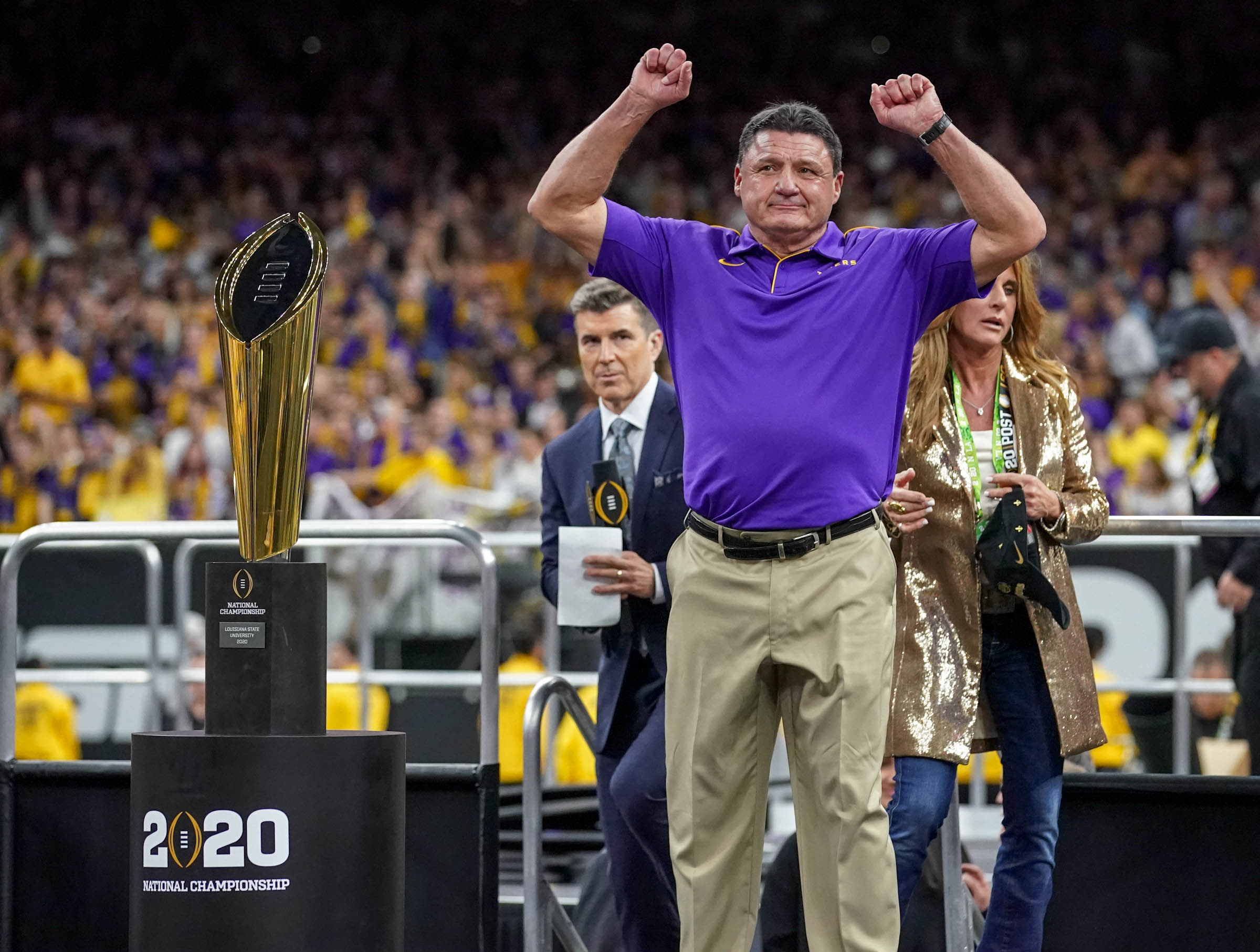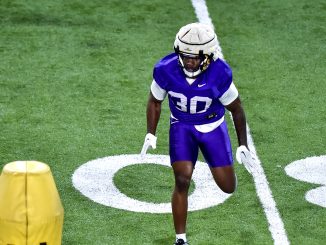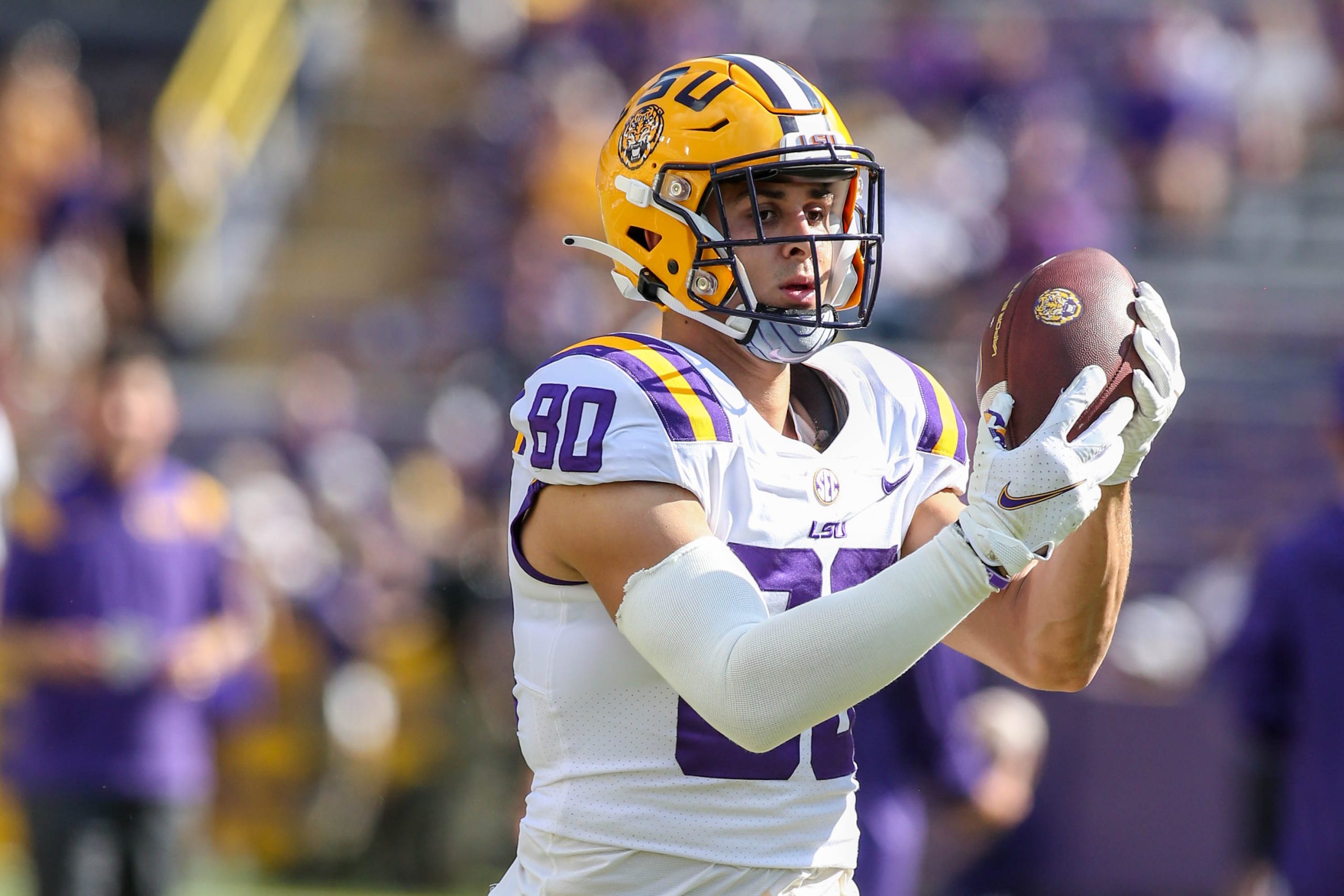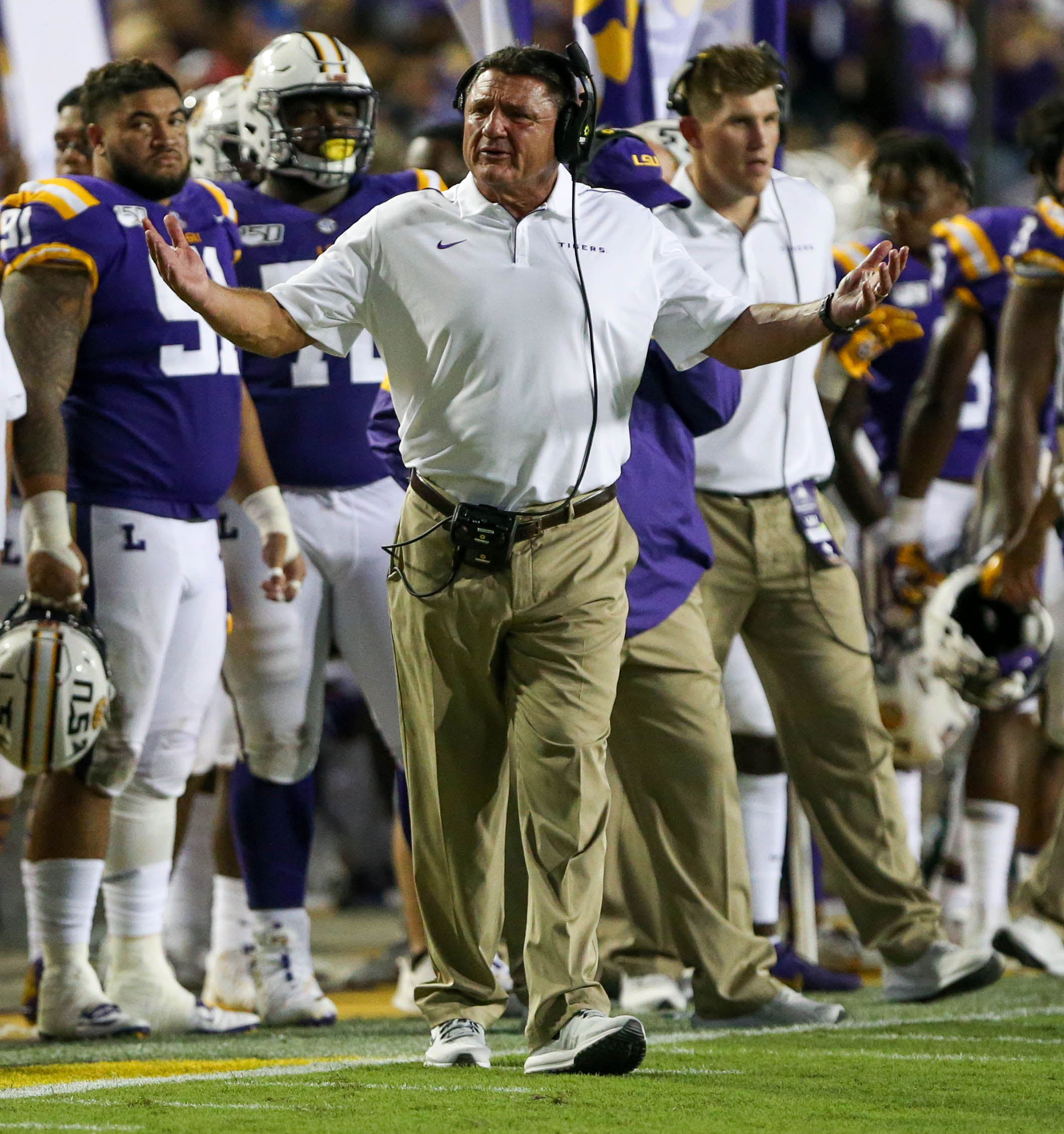
On a beautiful spring Tuesday afternoon, LSU coach Ed Orgeron is standing on his second-floor office patio in the football operations building.
It is one of his favorite features of the building’s $28 million renovation that made it the envy of college football when it was unveiled last July.
His patio, which sits to the right of the main entrance gives him the perfect view to survey his current national championship kingdom.
But the patio also has other purposes. It is his place of solace and selling.
Every morning when Orgeron arrives at work at 6, he first goes to the patio and recites a daily prayer.
“Lord, thank you for this opportunity at Louisiana State University. Please give me the words and that wisdom that you want me to lead these men today. In Jesus name we pray. Amen.”
The patio is also the spot Orgeron brings high school prospects to secure a commitment. It’s also an ideal vantage point for him to Facetime with recruits from coast-to-coast.
In either case, his recruiting pitch is identical.
First, he points to the 17-month old Nicholson Gateway apartments built on the old Alex Box Stadium site.
“That’s where you live,” he says.
He points in the general direction of the campus past the Pete Maravich Assembly Center.
“That’s where you go to school,” he says.
He points at the football operations building front door.
“This is where you train,” he says.
He turns toward the lush green practice fields.
“This is where you develop,” he says.
Finally, he turns again and faces Tiger Stadium.
“And that’s where you shine on Saturday night,” he says with the expected gusto of one of college football’s most persuasive recruiters.
Normally, Orgeron is not on his patio in late afternoon in the fall or the spring. He’s with his players and coaches on the Tigers’ practice fields, a place the 59-year-old always believed he was destined to be just 100 miles from his south Louisiana hometown of Larose.
In fact, this particular Tuesday was scheduled to be LSU’s fourth spring practice for a team trying to mesh three new assistants while replacing 16 starters off last year’s 15-0 picture of perfection that was regarded as one of the best teams in college football history.
But the worldwide pandemic of the deadly coronavirus brought the world to a halt. In hopes of slowing the spread of a virus with no proven vaccine yet, everything has been shut down except for essential services such as hospitals, grocery stores and drugs stores.
Schools are closed with colleges seeking to finish the semester by teaching on-line. All pro and college athletic events cancelled, including practices. All student-athletes, except for the international ones who are unable to vacate, have gone home.
The once-bustling LSU campus is silent and empty. There’s just a smattering of cars in the front football ops building parking lot belonging to coaches still on the job doing their best to be ready to resume practice whenever that day comes.
“We just take it a day at a time,” Orgeron says. “But I do believe we’re in for the long haul. We could be shut down for three months. It’s out of our control. Let’s chill.”
Time on his hands
The thought of Orgeron, known for his boundless upbeat energy and his relentless recruiting, advising mankind to “chill” is chilling.
Especially from someone who promised at his March 4 pre-spring press conference that he will “work harder than ever this year.”
“I’m about as chill as I’m going to be,” Orgeron says after the latest life-alerting events. “I’m going to work my tail off.”
Even with no team to coach, Orgeron arrives at the office at 6 a.m., heads to his patio, prays and then does a weight workout in his office (“They shut down our weight room, so they set me up with a full weight bench and dumbbells,” he said).
After that, he watches video tapes of prospective recruits and then calls, or messages recruits the rest of the day.
He also has emerged as the focal point of state-wide public service announcements urging the Louisiana public to stay home and follow the plan of social distancing.
Orgeron was invited by Louisiana Gov. John Bel Edwards last Wednesday to sit in on a briefing at Louisiana’s operation center and then speak at a media conference.
A reporter asked Orgeron, “Lots of people are afraid right now, why isn’t fear a proper response and what would tell folks who are afraid?”
Orgeron quickly and calmly answered “Have faith. Have faith in the game plan. We’re gonna get through this. There’s gonna be some rough times, but we can’t give in to it. Fear makes you give in to it. Have faith. Grow strong. Grow as a team. Lean on each other.”
That sounds trite and maybe cliché but it’s the very foundation of Orgeron’s never-too-late career success, a well-documented coaching and life journey of ups and downs that led to one of the most perfect pairings in the history of matchmaking.
A south Loo-zi-ana Cajun coaching the El-S-Yew Ti-gahs.
From day one in the most or second most important seat in Louisiana along with the governor (it all depends who’s having a better year), Orgeron has hammered home his “one team, one heartbeat” mantra.
It isn’t an Orgeron creation. The updated version of “one for all and all for one” has been used by many coaches in various sports in all levels for years and years.
But as the only SEC head football coach currently coaching in his native state, his opening statement at the press conference when he was hired in late November 2016 as head coach – “This isn’t about me, this is about the people of Louisiana, it’s about LSU and about all of us pulling together. . .One team, one heartbeat” – resonated because he’s a native son who has lived and breathed the passion of LSU football from childhood.
To Orgeron, the LSU program is his family and he’s doing his best not to feel out of sorts and stay positive with all his “sons” currently not under his roof for an undetermined amount of time.
“Things started really getting serious Thursday (March 12 when the SEC shut down all sporting events through March 30),” Orgeron recalls. “Our athletic director (Scott Woodward) said this thing was moving fast.
“We had a great practice that day. It was physical, our first day in pads. The next day on Friday, we had to cancel the second day of our high school coaches clinic but our team had a football school day where we had most of them in the film room and some of them in walk-through.
“Then at 1 o’ clock, everything changed again.”
The SEC announced it extended its suspension of play from March 30 to April 15. The league also banned all practices, meetings, team workouts and on and off campus recruiting visits.
Even then, Orgeron planned how to keep the team together until the following Thursday when spring break was supposed to start.
“My first mindset,” Orgeron says, “was `All right, we’re going to stay here, we’re not to break any rules but we’re going to compete. Our players are going to find a place to work out. This is chance for (new starting quarterback) Myles (Brennan) to be a leader. We can’t coach them, but they can have 7-on-7 practice and groups can work out together.
“We’re going to keep our cafeteria open and have study hall to catch up some guys that are behind academically.
“The coaches are going to meet, we’re going to watch cut-ups (tape) of our spring. In the afternoon, we’re going to recruit because all the recruits were home. We were going to crush it.
“We all were not going to blink while always keeping the players safety in mind.
“And then on Monday, it changed again. Our campus is closing. I have to send all our players a text to go home.”
So again, another adjustment.
Without practice or daily conditioning and strength training, how much can players fall out of shape? What can be done about that while keeping them safe?
“(LSU strength and conditioning coach) Tommy Moffitt did an amazing job,” Orgeron says. “He gave them workouts they could do if they had access to weights and if they didn’t have access to weights.”
Moffitt issued each player a handout of what workouts they should do. He also e-mailed them a PDF version a week as links to video tutorials demonstrating each workout.
There are five different workouts, based on equipment availability, everything from a player having access to a training facility to only having some free weights at home to Tabata training which are high-intensity exercises requiring no weights.
Plus, there’s the individual position-specific drills that players can do on their own.
“I think most of the guys are going to work out, they’re driven,” Orgeron says. “But what’s hard is we’re not together. This was to be a new spring with a new team and new coaches going through the grind.
“Now, I don’t know when we’re going to practice again. Maybe in June, we can start football school. The summer is going to be critical for us.
“The team that does the best of staying in shape is the team I believe that’s going to have success, especially early in season. That’s our challenge.”
An impossible act to follow
A year ago, at this time, Orgeron’s task was going all in on changing LSU’s offense to a spread passing attack with a mix of run/pass option.
It was a team full of good players, but no one besides safety Grant Delpit had been even a first-team All-SEC selection much less an all-American.
But there was excellent veteran leadership and the team, especially the offense, had bought into new passing game and RPO concepts installed by youthful first-year passing game coordinator Joe Brady, who Orgeron hired from the New Orleans Saints.
“Honestly, Joe Brady was just a quality control guy with the Saints,” Orgeron admits. “I wanted the Saints offense. I knew he knew the RPOs. Whoever thought Joe Brady would do what he did? Whoa!”
All Brady did, teaming perfectly with veteran offensive coordinator Steve Ensminger, was create the most prolific offense in college football history setting season-records of 48.4 points and 568.4 yards.
It turned Ohio State grad transfer quarterback Joe Burrow into a Heisman Trophy touchdown passing machine, transformed receivers Ja’Marr Chase and Justin Jefferson into a Biletnikoff Award winner and an SEC single-season receptions holder respectively, and renovated running back Clyde Edwards-Helaire into a first-team All-SEC selection.
The team, from top to bottom, was a unique mix of veteran leadership and hungry, unproven players eager to establish themselves. Because of that, they all held each other accountable, reducing any off-the-field problems to virtually zero.
“(LSU trainer) Jack Marucci has some sort of analytical program that measures character,” Orgeron reveals. “He comes to me before last season and says `This is the highest character team we’ve had since the (2007) national championship team. I’m not going to tell you they are the most talented, but they are the highest character team.’
“Jack nailed it. Character wins. There’s no room for that silliness anymore. This is college sports, it’s too serious. The SEC West is like the NFL. It’s too serious to put up with any silliness.
“Our players bought in and they believed. You can have a team that buys in, but you’ve got to believe. They could smell it.”
Until now, Orgeron hasn’t had time to reflect on last season. And when he does, it usually comes in bits and pieces and starts the day Burrow showed up for his first day of summer workouts in June 2018.
“We ran 16 110s and he won every one of them,” Orgeron remembers with a smile. “Joe didn’t say a word.
“When the quarterbacks went to throw, everybody went with the other quarterbacks. Foster Moreau, who hosted Joe on his visit, was the only receiver the first day to go catch his passes warming up.
“The next day, Joe won everything. He went and passed to Foster again and you could see the other receivers watching. The next day, one or two went over there and joined Joe and Foster and before you knew it, he had the whole team.”
Last season with Burrow and LSU’s new offense a perfect fit, Burrow’s confidence was infectious.
“With some of those plays he made, the scrambles he made and the confidence he exuded in the football team, we knew we could win every game,” Orgeron says. “I became a fan on the sideline. Instead of being a coach grinding it, I was like “Wow, look at that play, go, go, goooo.’
“Steve called about 75 percent of the plays and Joe Brady handled the red zone and goal line situations. It was just amazing to watch.”
Especially the heady and calm Burrow, who was on radar lock with his passing accuracy and decision-making.
“Joe was all about second and third level thinking, you talk about awareness,” Orgeron says. “Joe came off the field in a game and our line coach (James) Gregg asked him, `Why didn’t you change the protection?’
“Joe says, `I had one of the freshmen running backs in there. I know if I changed the protection, he was hot, and he doesn’t catch the ball very well going to his left.’”
Orgeron considers Burrow’s 61-yard TD pass to Jefferson on third-and-17 with 2:27 left to play for a 45-31 lead in an eventual 45-38 win at No. 9 Texas as the Tigers’ moment of truth on several levels.
Maybe the most important was confirmation of LSU’s new aggressive offensive philosophy.
“We didn’t play scared, we played to win,” Orgeron emphasizes. “Keep the pedal to the metal. Just let ’em go. Don’t be conservative. Don’t hold on to old ways. Just let ’em go. Just trust them.”
Even with LSU’s defense uncharacteristically struggling most of the season, whether it was because of key injuries or trying to adapt to going back on the field so quickly because of the Tigers’ quick strike offense, Orgeron never wavered.
“People asked me if I was going to slow our offense down,” Orgeron says. “Hell no, I’m not slowing them down. We’ve got to adjust on defense.
“When the other team scored on our defense, our offense said `Let’s go.’ They took it as a challenge.”
LSU’s offense scored 62.5 percent of the time (30-of-48 with 24 TDs, six field goals) after the Tigers’ opponent scored. Then-defensive coordinator Dave Arnanda’s unit gave up 31 points and 28 points in the second halves at Texas and Alabama respectively and LSU never lost the lead.
“The only time I got a little nervous was when Clemson was zero blitzing us against the spread and Joe couldn’t get the ball off,” Orgeron says of LSU gaining just 17 yards on its first three series with Burrow completing a mere 4-of-9 passes for 23 yards.
Then, Ensminger and Brady adjusted, LSU scored touchdowns on its next 4-of-5 possessions. Ball game, 42-25. National championship No. 4 in the bag for the Tigers.
Turning the page
It wasn’t until a few hours after LSU’s national championship parade and celebration five days after winning the title that Orgeron exhaled and pondered what had just been accomplished.
“I went home that night,” Orgeron says, “and went `Wow, what a season. What a season. Unbelievable.’
“But, then as a coach, you let it sink in for about an hour as you go to bed.
“Then, you wake up the next day and it’s `All right, baby, let’s roll.’ Let’s have the confidence to do it again and our players have got to feel that in me.”
Considering the world-changing events of the last two weeks, that euphoric Jan. 13 night in the Mercedes-Benz Superdome when Orgeron claimed the national title for his home state seems ions ago.
Even the start of spring practice on March 7 seems like a distant memory. That first practice was an eye-opener.
“There’s some deflation (of living off last season) that needs to happen,” Orgeron says. “I think some of the deflation was going on in the fourth quarter (LSU’s winter strength and conditioning workouts). And when practice started, the deflation continued because we didn’t look nowhere like the same team.”
Yet even with the uncertainty when the Tigers can reconvene for practice again, Orgeron is excited about the challenge of plugging in new starters like Brennan, coaching hires such as defensive coordinator Bo Pelini, passing game coordinator Scott Linehan and running backs coach Kevin Faulk and adding an array of new offensive and defensive analysts.
“I think it’s better because you bring in fresh ideas,” Orgeron says. “If we would have the same team, we’d be really good. But if we had the same players and the same coaches, things could go a little stale.
“Now, we’ve got new players who want to prove themselves, new coaches who want to prove themselves. There’s a lot of new energy.”
Watching tape of his team’s only three spring practices, Orgeron is encouraged by potential and effort. He likes the improvement of Brennan, enjoys the speed and attack mode of Pelini’s new 4-3 defense and marvels at the daily receiver/defensive battles between future NFL first-round draft choices Chase and Derek Stingley Jr.
“We now have a culture, the LSU `standard of performance’,” Orgeron says of the phase he lifted from late NFL coaching legend Bill Walsh. “The players understand that, and they hit the ground running. The coaches did a good job of installing in football school.”
Orgeron wishes he had more practice tape to watch and staff meetings to preside. He’s doing his best, like all of us, to maintain a sense of normalcy, a feeling of being productive during one of the worst, most uncertain and scary times in our lifetime.
In the meantime, he’ll likely be on his office patio every morning at 6 saying his daily prayers.
And while he’s at it, he might want to throw in few extra requests.
“This is all bigger than us,” he says looking wistfully at the empty practice fields.
[Message clipped] View entire message




Coach O would set a better example for all of Louisiana if he stayed home!